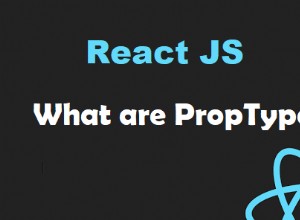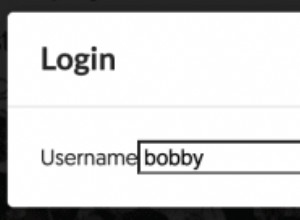不使用 jQuery 編寫 JavaScript 的 10 個技巧
jQuery 是一個很棒的庫。大約在 IE6 成為排名第一的瀏覽器的時候。那時,有一些怪癖和差異需要解決,而 jQuery 是編寫跨瀏覽器代碼的完美工具。
然而,今天,Web 瀏覽器比那些日子有了很大進步。我們可以輕鬆地使用 ES5 提供的所有功能,並且我們可以使用很棒的 HTML5 API,這些 API 使與 DOM 的工作變得更好。開發人員現在可以選擇在某些項目中不使用 jQuery,同時仍然保持生產力。
不要誤會我的意思——jQuery 仍然是一個很棒的庫,而且大多數情況下你會更好地使用它。但是,對於像 JS 交互有限的簡單頁面、瀏覽器擴展和移動網站等較小的事情,您可以使用 vanilla JS。這裡有 10 條提示,可以幫助您努力。
1。聆聽文件準備就緒
編寫 jQuery 時要做的第一件事是將代碼包裝在 $(document).ready() 中 調用,以便您知道 DOM 何時準備好進行操作。如果沒有 jQuery,我們就會有 DOMContentLoaded 事件。以下是它的使用方法:
// Add an event listener of DOMContentLoaded to the whole document and call an anonymous function.
// You can then wrap your code in that function's brackets
// and it will execute once loading is complete.
document.addEventListener('DOMContentLoaded', function () {
// Our hawaiian greeting is displayed as soon as the page loads,
console.log('Aloha');
});
2。選擇元素
曾幾何時,我們只能通過 id、class 和標籤名稱來選擇元素,而 jQuery 憑藉其類似 css 的智能選擇器成為了救命稻草。從那以後,瀏覽器開始流行起來,並引入了兩個重要的 API - querySelector 和querySelectorAll:
// We can use document.querySelector to get the first element that matches a certain criteria.
// It's only argument is a string containing one or more CSS selectors.
var lochNess = document.querySelector(".monsters");
console.log("It's from Scotland - " + lochNess.textContent);
// We can also get all elements of a certain type or class by using document.querySelectorAll.
// This returns a NodeList of all the elements that fit our criteria.
var scary = document.querySelectorAll(".monsters");
console.log("Hide and seek champions: ");
for (var i = 0; i < scary.length; i++) {
console.log(scary[i].innerHTML);
}
<ul>
<li class="monsters">Nessy</li>
<li class="monsters">Big foot</li>
<li class="monsters">La chupacabra</li>
</ul>
3。附加和移除事件監聽器
監聽事件是構建 Web 應用程序的基本部分。曾經有兩個主要陣營在如何完成這一點上有所不同 - IE 和其他陣營。但是今天我們只使用 addEventListener :
var btn = document.querySelectorAll("button"),
list = document.querySelector("ul");
// We call the addEventListener method on our desired event target(in this case a button).
// This will start a listener that will wait until a click is generated on the element.
btn[0].addEventListener("click", function () {
// When this button is clicked we want to enable zooming of our list.
// To do this we add an event listener to our list itself,
// so when the cursor hovers it, the enlarge function gets called.
list.addEventListener("mouseover", enlarge);
});
// To disable the zooming we can simply use removeEventListener.
btn[1].addEventListener("click", function () {
// Removing event listeners doesn't work on anonymous functions, so always use a named one.
list.removeEventListener("mouseover", enlarge);
});
// Let's create our enlarge function.
var enlarge = function () {
// Add class zoomed to the unordered list.
list.classList.add("zoomed");
// When the cursor leaves the list return to normal size by removing the class.
list.addEventListener("mouseout", function () {
list.classList.remove("zoomed")
});
};
// Now we want to be able to color the names by clicking them.
// When a 'click' is registered on one of the list entries it should change its color to green.
// Thanks to event delegation we can actually add an event listener to the whole parent object.
// This way we don't have to add separate event listeners to each <li>.
list.addEventListener("click", function (e) {
// Make the coloring happen only to the clicked element by taking the target of the event.
e.target.classList.add('green');
});
<button>Enable zoom</button>
<button>Disable zoom</button>
<br><br>
Click on any of the names to color them green
<ul>
<li>Chewbacca</li>
<li>Han Solo</li>
<li>Luke</li>
<li>Boba fett</li>
</ul>
.green {
color: green;
}
.zoomed {
cursor: pointer;
font-size: 23px;
}
addEventListener 過去需要第三個參數(useCapture),但這已經有一段時間了。因此,代碼看起來更像 jQuery。
4。操作類和屬性
在沒有 jQuery 的情況下操作元素的類名過去非常不方便。不用了,多虧了 classList 屬性。如果你需要操作屬性,你有 setAttribute。
var btn = document.querySelectorAll("button"),
div = document.querySelector("#myDiv");
btn[0].addEventListener("click", function () {
// Get any attribute easily.
console.log(div.id);
});
// Element.classList stores all classes of the element in the form of a DOMTokenList.
var classes = div.classList;
btn[1].addEventListener("click", function () {
console.log(classes);
});
btn[2].addEventListener("click", function () {
// It supports adding and removing classes.
classes.add("red");
});
btn[3].addEventListener("click", function () {
// You can also toggle a class on and off
classes.toggle("hidden");
});
<div id='myDiv' class="square"></div> <button>Display id</button> <button>Display classes</button> <button>Color red</button> <button>Toggle visibility</button>
.square {
width: 100px;
height: 100px;
margin-bottom: 20px;
border: 1px solid grey;
border-radius: 5px;
}
.hidden {
visibility: hidden;
}
.red {
background-color: red;
}
5。獲取和設置元素內容
jQuery 有方便的 text() 和 html() 方法。取而代之的是我們已經使用了很長時間的 textContent 和 innerHTML 屬性:
var myText = document.querySelector("#myParagraph"),
btn = document.querySelectorAll("button");
// We can easily get the text content of a node and all its descendants.
var myContent = myText.textContent;
console.log("textContent: " + myContent);
// When using textContent to alter the text of an element
// it deletes the old content and replaces it with new.
btn[0].addEventListener('click', function () {
myText.textContent = " Koalas are the best animals ";
});
// If we want to grab all the HTML in a node (including the tags) we can use innerHTML.
var myHtml = myText.innerHTML;
console.log("innerHTML: " + myHtml);
// To change the html simply supply new content.
// Of course we aren't limited to text only this time.
btn[1].addEventListener('click', function () {
myText.innerHTML = "<button> Penguins are the best animals </button>";
});
<p id="myParagraph"><strong> Which are the best animals? </strong></p> <button>Koalas</button> <br> <button>Penguins</button>
6。插入和刪除元素
儘管 jQuery 使它變得更容易,但使用純 JavaScript 添加和刪除 DOM 元素並非不可能。以下是如何添加、刪除和替換您想要的任何元素:
var lunch = document.querySelector("#lunch");
// In the HTML tab we have our lunch for today.
// Let's say we want to add fries to it.
var addFries = function () {
// First we have to create our new element and set its content
var fries = document.createElement("div");
fries.innerHTML = '<li><h4> Fries </h4></li>';
// After that's done, we can use appendChild to insert it.
// This will make our fries appear at the end of the lunch list.
lunch.appendChild(fries);
};
// Now we want to add cheese both before and after the beef in our burger.
var addCheese = function () {
var beef = document.querySelector("#Beef"),
topSlice = document.createElement("li"),
bottomSlice = document.createElement("li");
bottomSlice.innerHTML = topSlice.innerHTML = 'Cheese';
// Inserting the top slice:
// Take the parent of the beef (that's the sandwich) and use insertBefore on it.
// The first argument to insertBefore is the new element we're gonna add.
// The second argument is the node before which the new element is inserted.
beef.parentNode.insertBefore(topSlice, beef);
// The bottom slice:
// We have to use a little trick here!
// Supply the next nearest element as the second argument to insertBefore,
// that way we can actually insert after the element we want.
beef.parentNode.insertBefore(bottomSlice, beef.nextSibling);
};
var removePickles = function () {
// Finally, we want to get rid of those pickles. Again javascript got us covered!
var pickles = document.querySelector("#pickles");
if (pickles) {
pickles.parentNode.removeChild(pickles);
}
};
// Delicious!
var btn = document.querySelectorAll("button");
btn[0].addEventListener('click', addFries);
btn[1].addEventListener('click', addCheese);
btn[2].addEventListener('click', removePickles);
<button>Add fries to lunch</button>
<button>Add cheese to sandwich</button>
<button>Remove pickles</button>
<h3>My Lunch</h3>
<ul id="lunch">
<li><h4>My sandwich</h4></li>
<li>Bread</li>
<li id="pickles">Pickles</li>
<li id="Beef">Beef</li>
<li>Mayo</li>
<li>Bread</li>
</ul>
7。遍歷 DOM 樹
每個真正的 JS 忍者都知道,DOM 中隱藏著很多力量。與 jQuery 相比,普通 DOM API 提供的選擇祖先或兄弟姐妹的功能有限。但是,您仍然可以做很多事情來穿越這棵樹。
var snakes = document.querySelector('#snakes'),
birds = document.querySelector('#birds');
snakes.addEventListener('click', function (e) {
// To access the parent of a certain element in the DOM tree, we use the parentNode method.
var parent = e.target.parentNode;
console.log("Parent: " + parent.id);
// For the opposite, calling the .children method gets all child elements of the selected object.
console.log("Children: ");
var children = e.target.children;
// This returns a HTMLCollection (a type of array), so we have to iterate to access every child's content.
for (var i = 0; i < children.length; i++) {
console.log(children[i].textContent);
}
});
birds.addEventListener('click', function (e) {
// Getting the nearest sibling to our element is self-explanatory.
var previous = e.target.previousElementSibling;
if (previous) {
console.log("Previous sibling: " + previous.textContent);
}
var next = e.target.nextElementSibling;
if (next) {
console.log("Next sibling: " + next.textContent);
}
// However, to acquire all the siblings of a node is a bit more complex.
// We have to take all of its parent's children and then exclude the original element.
// This is done by using filter and calling a function that checks every child one by one.
console.log("All siblings: ");
Array.prototype.filter.call(e.target.parentNode.children, function (child) {
if (child !== e.target) {
console.log(child.textContent);
}
});
});
Click on the objects to see their parent and children elements
<div id="snakes">
Snakes
<ul id="venomous">
Venomous
<li>Cobra</li>
<li>Rattlesnake</li>
</ul>
<ul id="non-venomous">
Non venomous
<li>Python</li>
<li>Anaconda</li>
</ul>
</div>
Click on any of the birds to see its siblings
<div>
Birds
<ul id="birds">
<li>Flamingo</li>
<li>Seagull</li>
<li>Raven</li>
<li>Dodo</li>
</ul>
</div>
div {
color: white;
background-color: #93d0ea;
font-family: sans-serif;
width: 180px;
text-align: center;
padding: 10px;
margin: 5px;
}
8。遍歷數組
jQuery 提供的一些實用方法在 ES5 標準中可用。對於迭代數組,我們可以使用 forEach 和 map 而不是它們的 jQuery 版本 - each() 和 map() .請注意參數和默認值的差異 this 回調中的值。
var ninjaTurtles = ["Donatello", "Leonardo", "Michelangelo", "Raphael"];
// ForEach automatically iterates through an array.
ninjaTurtles.forEach(function (entry) {
console.log(entry);
});
// The map method calls a function on every element of an array and creates a new array with the results.
var lovesPizza = ninjaTurtles.map(function (entry) {
return entry.concat(" loves pizza!");
});
console.log(lovesPizza);
9。動畫
jQuery 的 animate 方法優於您可以自己粘合在一起的任何方法,如果您的應用程序中需要復雜的可編寫腳本的動畫,您仍然應該堅持使用它。但是由於 CSS3 的所有奇蹟,一些簡單的情況可以使用像 Animate.css 這樣的輕量級庫來處理,它使您能夠通過向元素添加或刪除類名來觸發動畫。
var btn = document.querySelectorAll("button"),
circle = document.querySelector("#circle");
// First, we have to add a class of animated to our object, so the library can recognize it.
circle.classList.add('animated');
// We iterate over all of our buttons and add event listeners to each one.
for (var i = 0; i < btn.length; i++) {
// Define an anonymous function here, to make it possible to use the i variable.
(function (i) {
btn[i].addEventListener('click', function () {
// To start an animation you just have to add a specific class to the object.
// In our case we stored the classes' names in the data-animation attribute of each button.
var animation = btn[i].getAttribute('data-animation');
circle.classList.add(animation);
// To make it work more then once we have to remove the class after the animation is complete.
window.setTimeout(function () {
circle.classList.remove(animation);
}, 1000);
});
}(i));
}
<button data-animation="bounce">Bounce</button> <button data-animation="pulse">Pulse</button> <button data-animation="fadeInLeftBig">Fade in</button> <button data-animation="fadeOutRightBig">Fade out</button> <button data-animation="flip">Flip</button> <div id="circle"></div>
body {
text-align: center;
}
#circle {
border-radius: 50%;
margin: 50px auto;
width: 50px;
height: 50px;
background-color: #93d0ea;
}
10. AJAX
AJAX 是另一種曾經是跨瀏覽器混亂的技術。好消息是我們現在可以在任何地方使用相同的代碼。壞消息是,使用 XMLHttpRequest 實例化和發送 AJAX 請求仍然很麻煩,因此最好將其留給庫。但是你不需要僅僅為此包含整個 jQuery。您可以使用眾多可用的輕量級庫之一。這是一個直接構建 AJAX 請求的示例,並且使用了小的 reqwest 庫:
// This simple example logs the body of our url (a html file) in the console.
// It's possible to do a manual GET request but it is somewhat a tedious task.
var request = new XMLHttpRequest();
request.open('GET', 'https://tutorialzine.com/misc/files/my_url.html', true);
request.onload = function (e) {
if (request.readyState === 4) {
// Check if the get was successful.
if (request.status === 200) {
console.log(request.responseText);
} else {
console.error(request.statusText);
}
}
};
// Catch errors:
request.onerror = function (e) {
console.error(request.statusText);
};
request.send(null);
// Using a small library, such as Reqwest, can make your job much easier.
reqwest({
url: 'https://tutorialzine.com/misc/files/my_url.html',
method: 'get',
error: function (err) {
},
success: function (resp) {
console.log(resp);
}
});
結論
爭取最小化、零膨脹的網頁是一個有價值的目標,它將以更快的加載時間和更好的用戶體驗來回報自己。不過你應該小心——如果你重新發明 jQuery 給你的輪子,沒有人會贏。不要僅僅為了減少字節計數而犧牲良好的開發實踐。但是有很多地方可以完全適用今天的技巧。下次試試香草味,它可能就是你所需要的!




